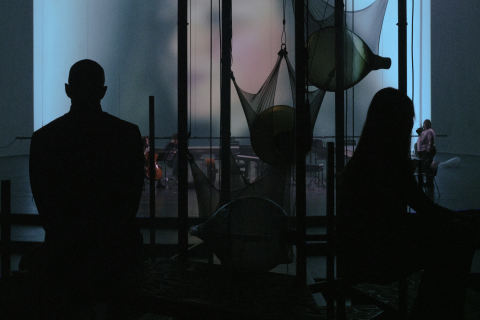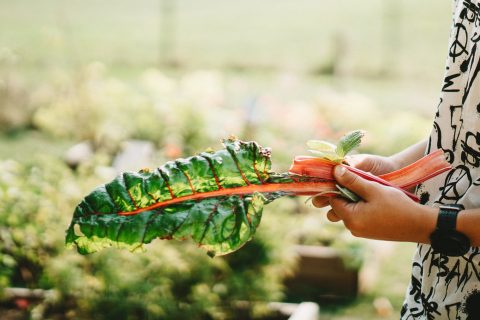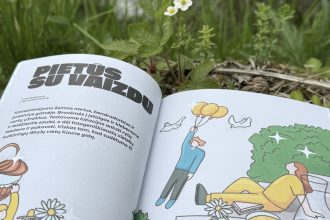I would like to add a soundtrack to this interview – a background that accompanied the entire conversation. It would combine birdsong, the crunching of branches underfoot, and the occasional gust of wind whirring in the phone receiver. I spoke with chef, food theorist, and educator Jonas Palekas as he was hiking “somewhere in the Švenčionys district.” Nature and food are the two areas that occupy the most space in Jonas’ life, so it made sense to talk about food culture, its contexts and meanings, surrounded by nature. In the autumn, during the Audra festival, Jonas Palekas will invite Kaunas residents to join the Citizen’s Sandwich project and reflect on the food culture in the city.


Jonas, tell us how you combined the professions of chef, food theorist, and educator in your life.
I’ve been interested in food since childhood – it was always clear to me what I wanted to do after finishing school. I’m grateful to my family and the community around me, who always accepted and supported me. When I was a teenager, a chef’s career didn’t seem romantic; it was understood simply as hard work. Thanks to my environment, I became involved in the cultural world, and the two fields – food and art – merged. Food and its practice and theory complement each other. Food is a very physical thing, experienced empirically, but it is also surrounded by theory. I am interested in the anthropology of food, the broader historical context surrounding food processes, what we eat, and what we might eat in the future. Food, cooking it or experimenting with it, acts as a practical medium, and theory allows me to think, complementing my actions in the kitchen with political ideas and philosophy.
Conscious consumption is very important to you. When did you realize this?
A long time ago, and now it seems like a given. Seasonality and locality are some of the aspects you realize when you first start to take a more serious interest in the factors that shape a food system that is healthy for nature and us. These components are fundamental, and they also exist within a broader cultural and historical context. These principles, although seemingly self-evident, are not easily implemented. Inevitably, we eat what is available in the store or at a restaurant. Seasonality and locality, due to their cost, often remain accessible only to the elite. The same goes for the restaurants that serve such food (fine dining): most people do not eat there every day.

In September, you will present the experimental food art project Citizen’s Sandwich in Kaunas in collaboration with Kultūros dirbtuvė, Šilainių sodai initiative, and artist and fermentation specialist Sean Roy Parker. What flavors and ideas can we expect?
This is a big project. During the Audra festival in Kaunas, we will open an artist-run café-diner-bakery-restaurant, and in general a place dedicated to experimental food practices. Right now we’re just trying to get a grip on the food context of Kaunas and find out what’s going on in the city. As a Lithuanian, this is not so new to me, as Kaunas is not an exclusive island, but rather one of the important components in the Lithuanian food picture, but for Roy there is a lot that is new and interesting. We traveled around the farms together, tasting, spending time in the markets, and getting to know the produce and the people. We will involve many talented people in this project, presenting food practices, and we hope to involve the community during the workshops and education, trying to answer the questions of what Kaunas food is, what it should(n’t) be, what we should eat in Lithuania and the region.
What is the food culture of Kaunas that you mentioned and are now researching?
It’s hard to give a precise answer. It is, for better or worse, very Lithuanian. Like the entire region, it has huge potential because we have preserved many of the elements and processes necessary for a healthy food system. For instance, Roy, who came from the UK, is very impressed by this. He claims that the British lost their connection to the land and their food about 300–400 years ago: neither his parents nor grandparents could tell him, for example, how to grow fruits or vegetables, and it’s hard to find a proper market, which is usually an essential part of a food system. When certain food trends reach the British – like composting or baking sourdough bread – they experience them as something completely new, and from the outside, it often looks like society treats them more as a game than a genuine, real interaction with their diet and local food traditions. In Lithuania, we haven’t strayed far from this connection, and that shows great potential. We will celebrate this during the Citizen’s Sandwich project as well. In Kaunas, it’s important to value local district farms and the Pilies Farmers’ Market which takes place on Saturdays. Of course, food culture in the city is also shaped by negative processes, especially in a highly competitive market. We can’t expect just a few restaurants like Nüman or Uoksas to define the city’s entire food identity. And I’ll repeat: what they do, while incredibly valuable, still falls more into the category of luxury than everyday services.
Your restaurant Delta Mityba was located in the artists’ and art space Autarkia, and the Citizen’s Sandwich will travel through the Audra festival spaces in autumn. What makes alternative venues appealing?
The fact that alternative spaces belonging to the world of culture allow for experimentation and a sense of boldness that the commercial context, which usually appropriates food processes, would not allow, is extremely valuable. When food is invited into the world of culture, and accepted as part of cultural processes, it no longer has to struggle in a conventional, commercial form and the competitive struggle for survival. For example, a restaurant can prepare quality food, but it has to sell it at a high price or find ways to produce it affordably. However, if it chooses the latter, you can’t expect high-quality ingredients. These harsh financial realities diminish many aspects of urban dining and often render it quite basic. In contrast, when we view food as a cultural product and invest in it, we can avoid these pitfalls, create a sense of security, and inspire change in the conventional food landscape.

Can food and the entire process of its production – growing, preparing, sharing – revive broken bonds, and strengthen existing communities?
Of course. When talking about communities, I would single out three layers. First, we understand community as those we eat with and sit around a shared table. Food brings people together through the act and ritual of eating. Sometimes we forget just how powerful and necessary that is. Second, communities as cultural entities shape food traditions, customs, and everything that comes along with food culture. When a community from another country visits, we communicate with it through food, so a kebab shop can become an opportunity to meet someone from the Middle East. Third is the food chain. We are a community: me, preparing the food; you, conducting an interview about food; the eater, consuming the food; the farmer, growing the food; and even the sheep, often becoming food and thus expanding the idea of community beyond just the human element. It’s the connection between different actors within the network and system. These community models provide a lot of food for thought, which is why such food relationships are especially important to us.
Can you see other areas where food can be used as a socially fulfilling experience?
That’s what fascinates me about food – the ability to connect different fields and its versatility. We can do a lot through food, for example, to have an impact, especially in the context of ecological problems. It’s a world that we all contribute to, for example, by choosing what we eat every day. After all, we eat several times a day, deciding what kind of produce it will be, or even which culture it will be. These decisions are political. Food possesses tremendous power, which may explain its appeal in the realms of art and culture. Although it can often seem invisible, it plays a crucial role that can be observed through various disciplines. Since Descartes, there has been a strong separation between the rational or spiritual and the corporeal world, leading to food being regarded as lesser in a world dominated by an exalted human mind. Today, this perspective is being called into question and criticized. It is essential to consider how we will act in the future.
We can develop taste, change habits, and make more informed choices. Where does food education start?
I come from a generation of chefs who say that the most important thing is to start with a quality ingredient and not to spoil it with your big ego, but to respect it and let it shine. We always come back to the same things: the origin of the ingredients, the desire to be curious about whether the food we eat is just deep-fried processed stuff or something of quality, whether we go to the market, whether we form habits, whether we taste. Having a relationship with food and taking an interest in it should not be a luxury. It’s often assumed that good food means things like oysters or truffles. But in our region, good food is local vegetables, mushrooms, berries, local dairy products, breads, smoked meats, or fermentation traditions. It also includes what people from other countries bring and refine here – but that doesn’t necessarily have to be anything luxurious. Most of these things are very familiar to what we have here; we just need to learn to take pride in them over time.
In one interview, you mentioned that you spent your childhood in your parents’ architecture studio. What influence did that early experience have on your current work?
My parents’ design studio, their team, and the creative processes really left an impression on me. I always had a dream of working in similar structures when I grew up – creative teams inspired me, and I was fascinated by how architecture could be applied and how it influenced everyday life. Food has a lot in common with that. And spaces, too: gardens, ovens, fire pits, and other elements of food-related environments are also very important to me. They are the starting point of my thought process. It is then that I create infrastructures that give birth to food. We’ll see that in Audra as well, and I’m glad I have people to collaborate with on this topic.
What’s inside the perfect picnic basket according to Jonas? And where do you most enjoy taking it?
I often go hiking or cycling in nature, so I choose food that’s nourishing and gives me a lot of energy. I often make a cult-favorite sandwich: a slice of dark rye bread, topped with a thick layer of good Lithuanian butter, and then a generous slice of white cheese. This sandwich must be paired with tea or kefir. The basket might also include some smoked meat from the Aukštaitija region and a good handful of dried apricots or plums – fruits from the Caucasus, which is also familiar to us through food. All of this is best eaten while sitting on a riverbank with a beautiful view of flowing water, waiting for a fish to leap from the stream.




